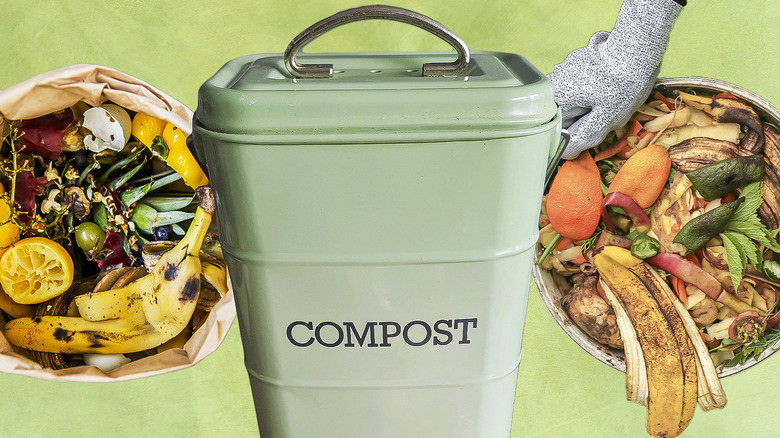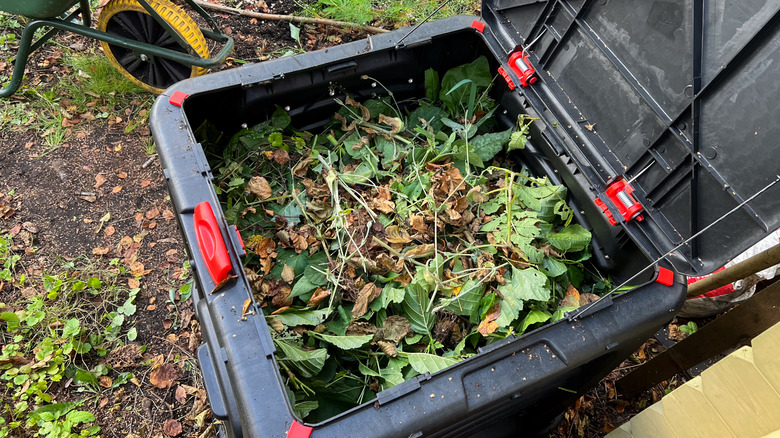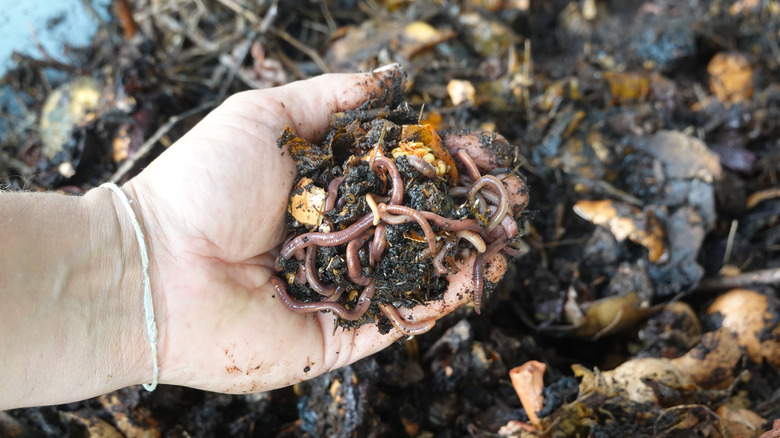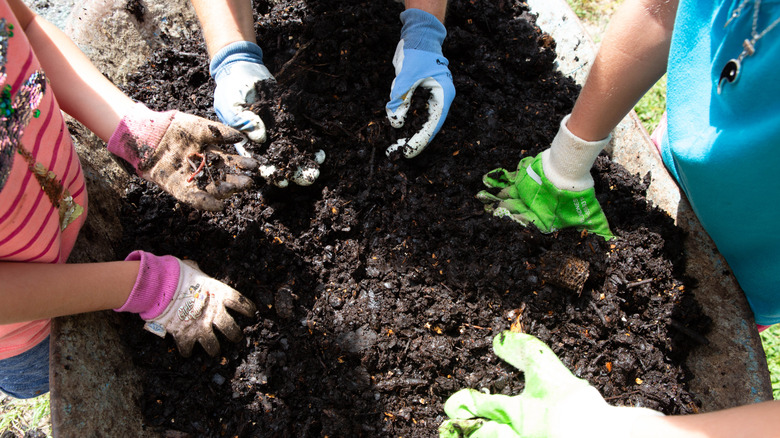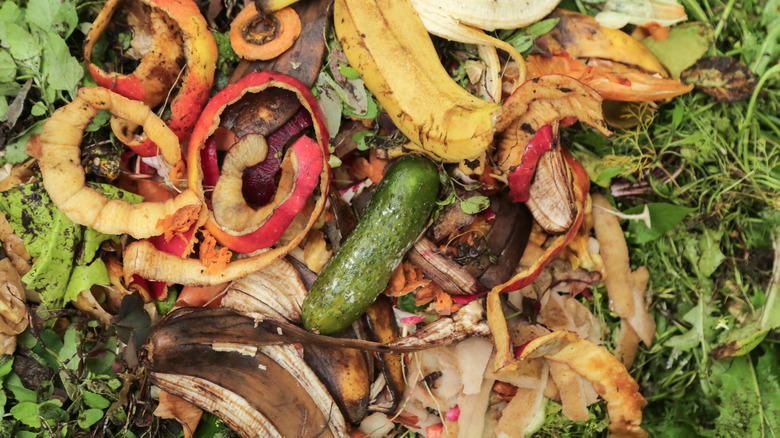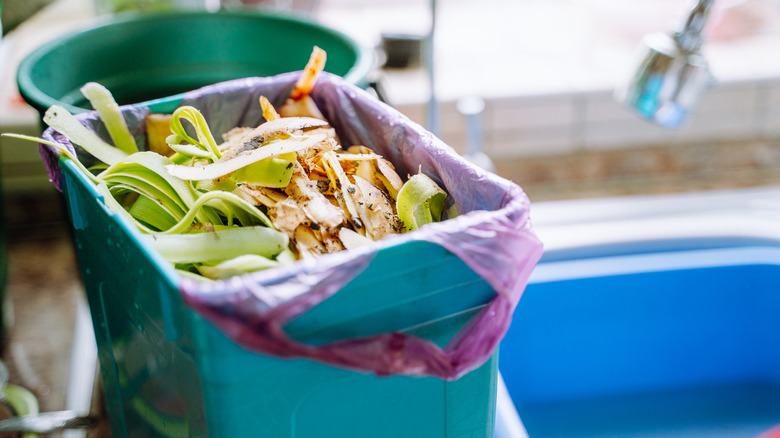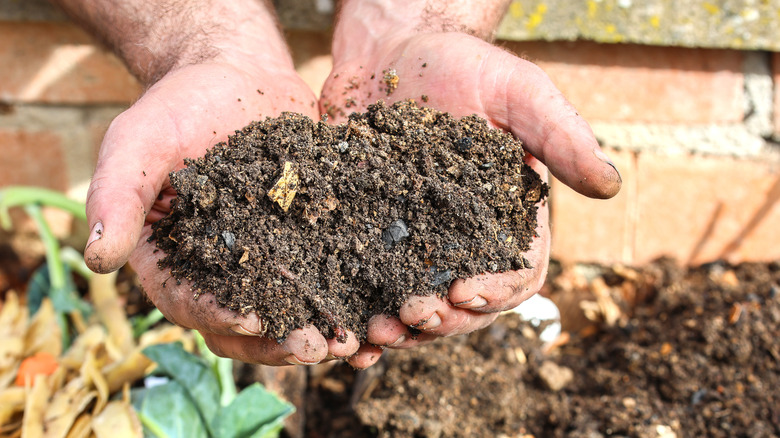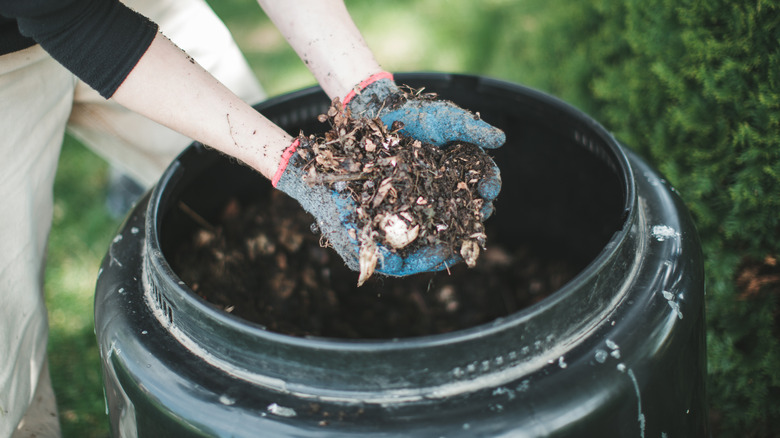The Ultimate Guide To Composting At Home: Everything You Need To Know
Want to make your kitchen more sustainable? Repurposing kitchen scraps, reducing food waste, and trying to minimize how much plastic you bring into the kitchen are all great ways to prioritize sustainability. If you want to take things a step further, though, you may want to consider learning how to compost at home. Sure, it does take some time to gather the equipment you need and to learn more about the process, but we spoke to Brenda Platt, director of the Composting for Community project for the Institute for Local Self-Reliance, about how you can get started easily.
Whether you live in a small apartment that barely has room for a spare flower pot or two, or you're trying to build a compost pile that can serve even the most avid gardener's needs, this info will get you started on your own composting path. The next time you make a big pot of soup or a big bowl of salad, you'll know exactly what to do with your leftover vegetable scraps.
Composting provides some very real benefits, both to individuals and the planet
We all know that it's great to have compost on hand if you're a gardener, since it can help keep your plants healthy and reduce the amount of fertilizer you have to use in your garden. But composting provides a lot of other benefits that you may not have thought of before. First of all, it reduces the amount of waste that ends up in landfills. More than a quarter of the waste we toss in the United States is food scraps or yard waste — in other words, stuff that could easily be composted instead of trashed — which creates a significant environmental burden in many ways, largely by creating methane emissions from landfills when the organic material starts to rot. Therefore, the less organic waste we throw into the waste stream, the better.
Compost can also improve the health of your soil, and healthier soil better retains water, which means that you have to use less of it. That's ideal for both your water bill and the planet. With so many different benefits to enjoy, it only makes sense to try composting for yourself, whether you use your own compost for at-home gardening or not.
Make sure you mix your greens and browns
In composting, you're working with two classes of materials: greens and browns. Greens are materials that will contribute nitrogen to the compost. They're things like food scraps and cuttings from your lawn. According to Brenda Platt, "Greens are more putrescible and will start to rot if they're not mixed with browns. You can't stockpile them but rather need to mix with browns as soon as you can to start the composting process." Browns, on the other hand, are drier forms of waste, like dried leaves or wood clippings. "Think of browns as materials that don't rot easily and won't smell if you stockpile them," says Platt. You need both to create a balance of both to achieve healthy compost. How much should you have of each? Per Platt, "You need at least twice as much browns as greens by volume."
The first layer of your composting bin should be browns, followed by a layer of greens. Continue this layering until you're out of materials or your compost reaches your desired height. Just make sure that your top layer of greens is completely covered by browns to avoid unpleasant odors and attracting pests. Turning the compost regularly results in active composting, which creates your compost faster than passive composting, which does not require you to turn the compost. Think about what works best for you, your schedule, and your gardening needs when you're trying to decide whether you want to actively or passively compost.
Vermicomposting is a great solution for apartment dwellers
We asked Brenda Platt whether composting is worth it if you live in an apartment and don't have a garden. "Depends," she said. "Do you have space for the composting system? Do you have a source of carbon-rich materials (aka 'browns') such as fall leaves, wood chips? Do you know people or community sites that could use your compost?" If the answers to those questions are "yes," then you may want to look into vermicomposting, or composting with worms.
First, you need to get a bin in which to house your compost. "You can build your own vermicomposting bin or buy one of the many branded options (such as Can-O-Worms, Worm Factory, Vermihut, Hungry Bin Worm Farm, Hot Frog Essential Living Composter, Uncle Jim's Composter, Urban Worm Bag, to name a few)," explains Platt. Then, you're going to need the worms. Out of the thousands of earthworm species on the planet, there are only seven that can successfully be added to a vermicomposting system. "In the United States, eisenia fetida worms are the most commonly used for vermicomposting."
Of course, having worms inside the home may not be for everyone, but it can be an especially fun project if you have kids. "[Kids] love worms. Worms are incredible communicators; that is, they won't eat food scraps they don't like, such as onions or tough broccoli stalks. Have fun with your kids and experiment with different scraps," suggests Platt.
Community composting is a smart option if you don't have the space to compost at home
Composting at home simply isn't feasible for everyone. Perhaps you don't have space in your home to store a composting vessel, or you simply don't know what to do with the compost after you create it. If you can't compost in your own home but still want to reap all of those incredible benefits, you might want to consider community composting. Some cities, like Cambridge, Massachusetts, provide city-wide composting. Just collect your food scraps in a container, then take them out in a separate bin with your trash once a week.
But perhaps your city doesn't offer composting on a large scale. You can also decide to create a compost bin with your immediate neighbors, a few friends, or even people you know from work or your kids' school. Not only does everyone contribute to the compost, but anyone who gardens can also benefit from it.
Brenda Platt says that even if these programs aren't immediately available in your local area, you can advocate for change. "Push your local planners and elected officials to support local composting infrastructure and to directly fund community-scale equipment and programs," she suggests. "They can provide technical assistance and training. They can also support reasonable policies and regulations, procure finished compost, contract with micro-haulers and processors, and provide long-term access to land."
Learn how to store your food scraps before composting them
If you're composting outside or utilizing community composting facilities, then you're going to have to store your food scraps before you can actually place them in the composting bin. So, how do you store them to ensure that they don't start to smell? Well, there are a few ways to pre-store your "greens," and our favorite is putting all of the scraps into a small container that you keep in your freezer. This way, the scraps won't rot and won't cause any unpleasant odors in your home.
Alternatively, if you tend to take your compost-bound scraps to the bin often, you can keep them in a closed container in the fridge or even under your sink. Just make sure that you keep the lid on this container at all times so it doesn't start to attract pests. Then, whenever you have the time, you can incorporate those food scraps into your compost bin.
Take time to learn about what you can and cannot compost
You probably produce a decent amount of food scraps in your kitchen while you're cooking. But how can you know which types of materials you can and cannot compost? Brenda Platt outlines what beginner composters should focus on when they're just getting started: "If you're new to composting, start with fresh vegetable and fruit scraps as your greens." The next time you make a salad or a veggie-heavy stir-fry, be sure to save all those leftover ends and odd bits that didn't make it into the actual dish. These will form the "greens" of your compost.
On the other hand, there are some materials that you probably shouldn't be including in your compost. "Do not include any meat, dairy, greasy/oily, or cooked foods," instructs Platt. "Rodents are attracted to proteins, and greasy or oily foods can create odors." And those plants that you tried to keep alive but got overtaken by pests? According to Platt, you should "avoid putting diseased plants in your pile." Making breakfast and don't want to waste those eggshells? "Eggshells are fine, but crush them first!" Don't forget the leftover bread and egg cartons!
Compost isn't actually soil
If you've never composted before, then you may assume that you're just making soil when you compost. However, that's not really the case, according to Brenda Platt. "Compost is a living soil amendment," she explains. "It's not soil, but rather a soil enhancer full of stable, plant-available nutrients and rich in organic matter." Technically, then, compost is something you add to soil — not use as soil all on its own.
Just because it's not soil, though, doesn't mean it's not incredibly useful when it comes to planting. "I like to call it black gold," says Platt. "When added to soil, it has so many soil benefits! It enhances soil tilth and fertility, suppresses plant disease, stimulates root growth, improves cation exchange capacity (the ability of soil to retain nutrients), helps soil hold water, improves soil structure, and supports soil biology." So, not only is it going to ensure that your plants are as healthy as they can be, but it may also further reduce your gardening costs since it can cut down on the amount of water and pesticides you need to use.
Consider whether you want to do hot or cold composting
Once you decide to start composting at home, you're going to have to decide whether you want to try hot or cold composting. Hot composting tends to be a bit more intentional, while cold composting requires less labor but will take longer. "Composting is not rocket science but it's helpful to understand the basics," Brenda Platt explains. "The secret to good composting is aeration, moisture, and balancing nitrogen-rich materials (such as your food scraps) with carbon-rich materials (such as fall leaves, branches, and wood chips)."
When you have sufficient aeration, an optimal moisture level, and a proper ratio of greens to browns, your compost will generate beneficial bacteria that heat up the compost pile. Without all of these factors in order, your compost will break down slower without generating heat. If you choose to cold compost, you may struggle with weeds or unfortunate odors. However, if you choose to hot compost, you'll probably have to spend more time working on your compost, and you will ideally need a thermometer to make sure your compost is at the ideal temperature.
There are a few easy ways to reduce odors
Like we've previously mentioned, hot composting is better for controlling odors. But there are a few other ways to ensure the least-smelly compost possible. First of all, you'll want to make sure that your compost bin has a top to it. By enclosing the compost in one space instead of keeping it open at the top, you're automatically going to be cutting down on unpleasant smells. Additionally, if you keep your compost bin outside, make sure it's somewhere with adequate drainage, as excess moisture can cause problems.
Using plenty of browns, also known as bulking agents, can also cut down on smells. You may also be surprised to learn that adding manure to your compost bin can actually reduce, not increase, odors! Additionally, ensuring that your composting heap isn't too large can encourage better airflow and further reduce odors. Plus, don't forget that vermicomposting is an option, particularly in a small space — if done properly, it shouldn't smell at all.
